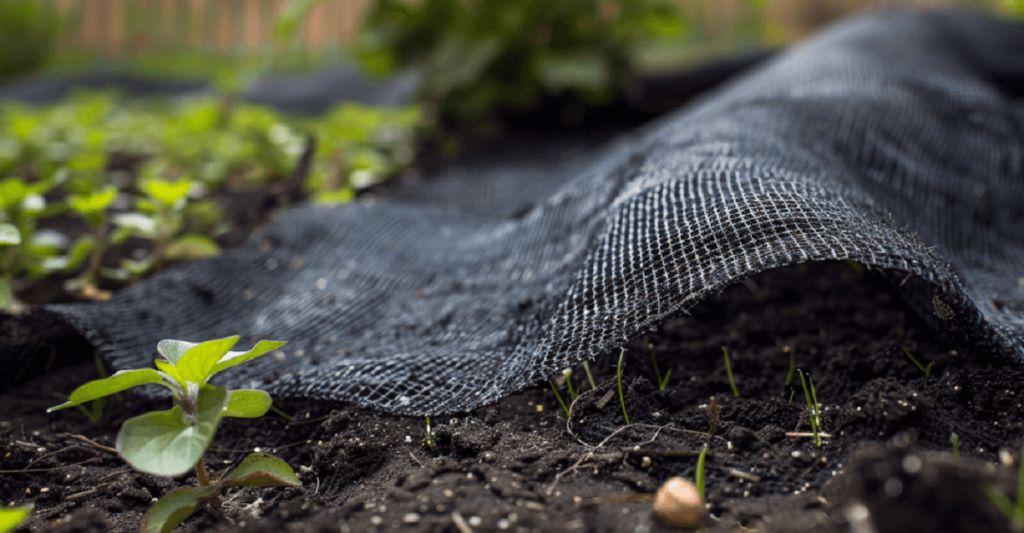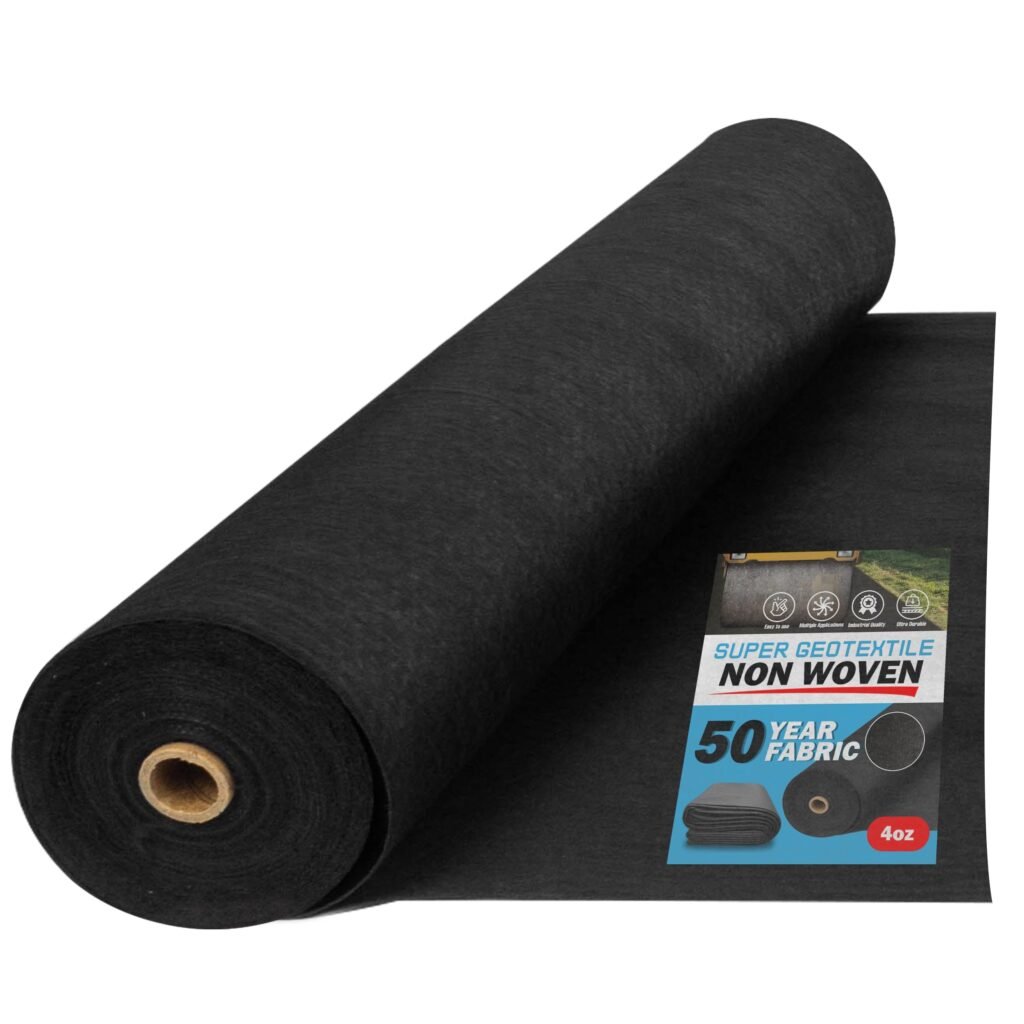Geotextile Applications and Benefits: Enhancing Soil Stability and Environmental Protection
Overview: Geotextile Applications & Benefits: Enhancing Soil Stability & Environmental Protection
Ad
Visit Now
This article delves into the multifaceted world of geotextiles, exploring their significant roles in civil engineering, agriculture, landscaping, & environmental protection. Initially, it defines geotextiles & traces their historical development, highlighting the evolution of materials used in their production. The article categorizes various types of geotextile materials & explains the manufacturing processes that create these essential tools.
A primary focus is placed on the diverse applications of geotextiles, showcasing how they enhance soil stability, prevent erosion, & facilitate effective drainage in civil projects. Specific sections address their vital role in agriculture, where they improve soil health & crop yields, as well as their use in landscaping to create environmentally sustainable designs.
While discussing the myriad benefits of geotextiles such as their cost-effectiveness, longevity, & environmental advantages the article also acknowledges the challenges & limitations inherent in their use. Best practices for installation, maintenance, & quality control are examined to ensure optimal performance.
Looking toward the future, the article explores innovations in geotextile technology, emphasizing sustainability & their potential contributions to global infrastructure development. It concludes with case studies that illustrate successful applications, underscoring the importance of proper disposal methods to mitigate environmental impact. Ultimately, the piece presents geotextiles as a sustainable solution that enhances soil stability & plays a crucial role in environmental protection.
জি টেক্সটাইল অর্ডার করতে ভিজিট করুন = Geobag Geotube and Geosheet
What is Geotextile?
Geotextile refers to synthetic fabrics used in civil engineering & construction. They provide excellent filtration, separation, & drainage solutions. These materials are crucial for soil stabilization, erosion control, & road construction. Engineers use geotextiles to improve the longevity & efficiency of structures.
Geotextiles are made from polymers such as polypropylene or polyester. Their design includes woven, non-woven, & knitted formats. Each type serves specific functions depending on the project requirements. Woven geotextiles offer high strength, while non-woven types provide good filtration capabilities.
| Type of Geotextile | Characteristics |
|---|---|
| Woven | High tensile strength, low elongation |
| Non-woven | Good drainage, high permeability |
| Knitted | Flexible, lightweight, good for reinforcement |
Applications of geotextiles include road construction, embankment stabilizations, & drainage systems. They reduce the movement of soil particles while allowing water to flow freely. This property helps to prevent soil erosion & improve structural integrity.
- Improves road durability
- Reduces maintenance costs
- Enhances drainage properties
Geotextiles also play a vital role in environmental protection. They can be used in landfill capping & waste containment. This application helps to prevent contaminants from leaching into the soil & groundwater.
In summary, geotextile is a versatile material widely used in construction & engineering. Its benefits include improved stability, longevity, & environmental protection. Geotextiles are essential for modern infrastructure projects, contributing to sustainable development.
The History of Geotextile
Publisher: upload.wikimedia.org
Geotextiles have a fascinating history, evolving from simple materials to advanced fabrics. Their origins trace back to ancient civilizations, where natural textile fibers were utilized. Early uses included soil stabilization & separation in construction. With the Industrial Revolution, synthetic materials began to emerge, paving the way for modern geotextiles.
In the 1950s, engineers started experimenting with synthetic polymers. The introduction of polypropylene & polyester changed the industry. These materials offered superior durability & functionality compared to natural fibers. By the 1970s, geotextiles became widely recognized for their benefits.
| Year | Event |
|---|---|
| 1950s | Introduction of synthetic materials |
| 1970s | Widespread recognition of geotextiles |
During the 1980s, research & innovation accelerated. New applications emerged in soil erosion control, drainage, & filtration. The use of geotextiles became common in road construction & railway projects, showcasing their versatility.
- Geotextile applications expanded significantly.
- Key uses included erosion control & drainage solutions.
Today, geotextiles play a crucial role in civil engineering & environmental projects. Their ability to enhance soil stability has made them indispensable. As technology progresses, future developments will likely bring further advancements in geotextile applications.
| Application | Benefits |
|---|---|
| Erosion Control | Prevents soil loss |
| Drainage Systems | Enhances water flow |
This journey illustrates their transformative impact. Understanding their history enriches our appreciation for geotextiles today.
Types of Geotextile Materials

Publisher: www.researchgate.net
| Type | Description |
|---|---|
| Woven Geotextiles | These are made from woven synthetic materials. They provide excellent strength & durability. |
| Non-Woven Geotextiles | Non-woven types are made from bonded fibers. They offer versatility in drainage & filtration applications. |
| Knitted Geotextiles | Knitted fabrics deliver flexibility & high elasticity. They are suitable for various construction processes. |
| Bioroll Geotextiles | These biodegradable options support vegetation growth. They help in soil erosion control & ecological restoration. |
Woven geotextiles are often used in heavy-duty applications. Their construction ensures superior strength & longevity. Non-woven geotextiles provide effective filtration & drainage solutions. They adapt well to various soil conditions & environments.
- Woven geotextiles are ideal for road & railway applications.
- Non-woven geotextiles excel in drainage systems & erosion control.
- Knitted geotextiles are perfect for structures needing flexibility.
- Bioroll geotextiles help promote plant growth in various environments.
This classification helps in selecting the right type for each project. Factors include soil type, project requirements, & environmental conditions. Using appropriate geotextiles enhances project efficiency & sustainability.
How Geotextile is Made

Geotextile is made from synthetic or natural fibers. These materials undergo several processes to achieve desired properties. The production begins with fiber selection based on specific requirements. Manufacturers typically use polyester or polypropylene for synthetic options. Natural fibers like jute or coir are also popular choices.
After choosing the material, the fibers are prepared. This includes cleaning & orienting the fibers for further processing. Next, the fibers are spun into yarn or fabric. This process can vary depending on the type of geotextile being produced.
| Fiber Type | Properties |
|---|---|
| Polyester | High strength & durability |
| Polypropylene | Water-resistant & lightweight |
| Jute | Biodegradable & eco-friendly |
Once the yarn or fabric is ready, it undergoes various treatments. These treatments may include weaving, knitting, or non-woven techniques. Each method affects the textile’s performance & application. Non-woven geotextiles are often preferred for their filtration properties.
- Weaving provides strength & stability.
- Knitting allows for flexibility & elasticity.
- Non-woven fabrics offer superior drainage capabilities.
After finishing the textile, quality tests are conducted. These tests ensure the geotextile meets industry standards. Factors such as permeability, tensile strength, & tear resistance are assessed. Finally, the product is ready for distribution to various construction projects.
Applications of Geotextile

Publisher: www.wallbarn.com
Geotextiles have numerous essential applications across various sectors. They are widely used in civil engineering projects. Geotextiles improve soil stability & drainage. This results in reduced erosion & enhanced road performance.
In road construction, geotextiles serve as filters. They separate soil layers while allowing water to flow. This helps maintain structural integrity & reduces maintenance costs. Geotextiles also assist in stabilizing slopes & controlling landslides.
| Application | Description |
|---|---|
| Soil Reinforcement | Improves load distribution & prevents soil movement. |
| Drainage Systems | Facilitates the movement of water, preventing flooding. |
| Erosion Control | Protects soil surfaces from wind & water erosion. |
Agriculture also benefits from geotextiles. They help with weed control & soil moisture retention. By preventing soil compaction, they enhance crop yields. And don’t forget, geotextiles improve the overall quality of agricultural lands.
- Used in landfills to manage waste containment.
- Applied in coastal protection to prevent beach erosion.
- Implement in pipeline projects to protect against soil movement.
Geotextiles find use in environmental engineering too. They play a role in constructing landfill covers & liners. This helps to seal off contaminants effectively. Their use promotes sustainable practices across multiple sectors.
As cities expand, geotextiles aid in urban development. They provide solutions for managing stormwater. By effectively controlling water runoff, they enhance urban resilience.
Overall, geotextiles provide versatile applications. Their role in engineering, agriculture, & urban development is crucial. They enhance sustainability & operational efficiency across numerous projects.
Benefits of Using Geotextile

Publisher: cdn-elmck.nitrocdn.com
Geotextiles play a significant role in construction & landscaping. They offer numerous advantages that enhance soil performance. One key benefit is soil stabilization. They prevent erosion & maintain soil integrity. This results in less damage to landscapes & structures.
Another benefit is their ability to improve drainage systems. Geotextiles allow water to flow through while filtering out soil particles. This helps prevent clogging in drainage systems. Consequently, better drainage leads to healthier plant growth.
| Geotextile Benefits | Description |
|---|---|
| Soil Stabilization | Reduces erosion & maintains soil structure. |
| Improved Drainage | Filters water while preventing soil clogging. |
| Cost Efficiency | Reduces maintenance costs in landscaping projects. |
And another thing, using geotextiles can enhance overall construction quality. They provide support for various applications, such as roads & driveways. Their durable nature ensures long-lasting protection against environmental factors.
- Facilitates vegetation growth in challenging areas.
- Minimizes soil movement caused by weather conditions.
- Easy to install, saving time & labor costs.
In summary, geotextiles offer multiple benefits that improve efficiency. Their application leads to safer & more sustainable projects. The use of geotextiles results in enhanced project outcomes across various industries.
Challenges & Limitations of Geotextile

Publisher: www.gowatersolve.com
Geotextiles provide numerous benefits, yet they face several challenges & limitations. One significant challenge is their durability. Certain geotextiles may degrade over time due to UV exposure or chemical reactions. This short lifespan can lead to increased maintenance costs.
Another limitation is their permeability. Some geotextiles are less permeable than expected, affecting drainage capabilities. This might lead to water accumulation, causing potential structural damage. Also, improper installation can diminish their effectiveness, compromising project outcomes.
| Challenge | Description |
|---|---|
| Durability Issues | Deterioration from UV & chemical exposure. |
| Permeability Concerns | Inadequate drainage may cause water buildup. |
| Installation Errors | Improper placement reduces overall performance. |
Additional factors include cost considerations & market availability. Geotextile products can vary significantly in price. Selecting low-quality options may result in early failure & increased expenses later. Supply chain issues can also restrict availability & choice.
- High variability in price & quality.
- Limited product availability based on location.
- Challenges related to environmental impact & sustainability.
Lastly, environmental factors play a role in their efficacy. Soil type & moisture levels can influence how geotextiles function. Understanding these variables can impact decision-making in various construction & landscaping projects.
Geotextile in Environmental Protection

Publisher: image.made-in-china.com
Geotextiles play a critical role in environmental protection. They are used to prevent soil erosion effectively. This technology helps retain soil moisture & supports vegetation growth. And don’t forget, they aid in managing stormwater runoff efficiently.
Geotextiles can filter pollutants in water. They act as a physical barrier to sediment while allowing water flow. Their application improves water quality in nearby ecosystems. They also reduce pollution & protect aquatic habitats.
| Geotextile Benefits | Description |
|---|---|
| Soil Stabilization | Prevents soil erosion on slopes & embankments. |
| Water Management | Facilitates efficient drainage & reduces flooding risks. |
The use of geotextiles in landfills improves waste containment. They prevent contamination of soil & groundwater from leachate. And another thing, they enhance the stability of landfill slopes. This contributes to more effective waste management practices.
- Supports vegetation in rehabilitation projects.
- Improves road construction & stability.
- Reduces impact during natural disasters.
In construction areas, geotextiles protect disturbed lands. They minimize erosion & sediment loss during projects. Implementing geotextiles leads to sustainable project outcomes. Thus, their role in environmental protection is invaluable.
Geotextile in Civil Engineering Projects
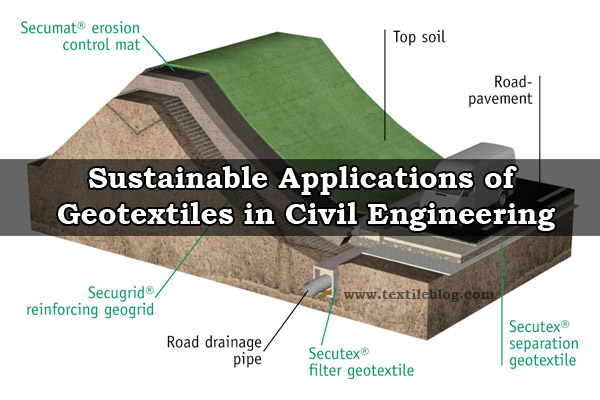
Publisher: www.textileblog.com
Geotextiles play a vital role in civil engineering projects. They improve soil stability & drainage. These materials are used in road construction, embankments, & retaining walls. Their application prevents soil erosion & increases lifespan. They filter water while allowing soil particles to remain intact.
| Geotextile Functions | Benefits |
|---|---|
| Separation | Prevents soil mixing, ensuring material integrity |
| Filtration | Allows water flow while retaining soil particles |
| Reinforcement | Enhances strength & stability of structures |
Various types of geotextiles exist. Woven & non-woven forms serve different purposes. Woven geotextiles are ideal for heavy load applications. Non-woven options offer excellent drainage & filtration.
- Improves load distribution on soft soils
- Reduces construction time & costs
- Minimizes environmental impact
Geotextiles support various applications in civil projects. They help reduce maintenance requirements for infrastructure. Their versatility makes them suitable for roads, bridges, & retention systems. Overall, they contribute to safer & more durable engineering solutions.
Geotextile in Agriculture

Publisher: d2t3x0k5v8rzxl.cloudfront.net
Geotextiles play a vital role in agriculture, enhancing soil stability & crop growth. These materials prevent soil erosion, minimizing the displacement of topsoil. They support better water management, ensuring optimal moisture retention. They also aid in weed control, reducing the need for herbicides. In addition, geotextiles improve root movement by creating a stable environment for plant growth. Farmers benefit from increased yields & healthier crops through their use.
| Benefit | Description |
|---|---|
| Soil Erosion Control | Reduces the loss of fertile topsoil. |
| Water Management | Helps retain moisture in agricultural fields. |
Geotextiles come in various types, each suited for specific agricultural needs. They can be made of synthetic or natural fibers, providing flexibility for different environments. Understanding the features of each type assists farmers in making informed decisions. Geotextiles designed for drainage keep soil aerated & prevent water logging.
- Improved Soil Structure
- Enhanced Crop Productivity
Incorporating geotextiles into farming practices offers sustainability benefits. They promote healthier ecosystems by reducing chemical runoff. Their use decreases maintenance costs over time. Employing geotextiles leads to a more sustainable approach in agricultural practices.
Geotextile in Landscaping
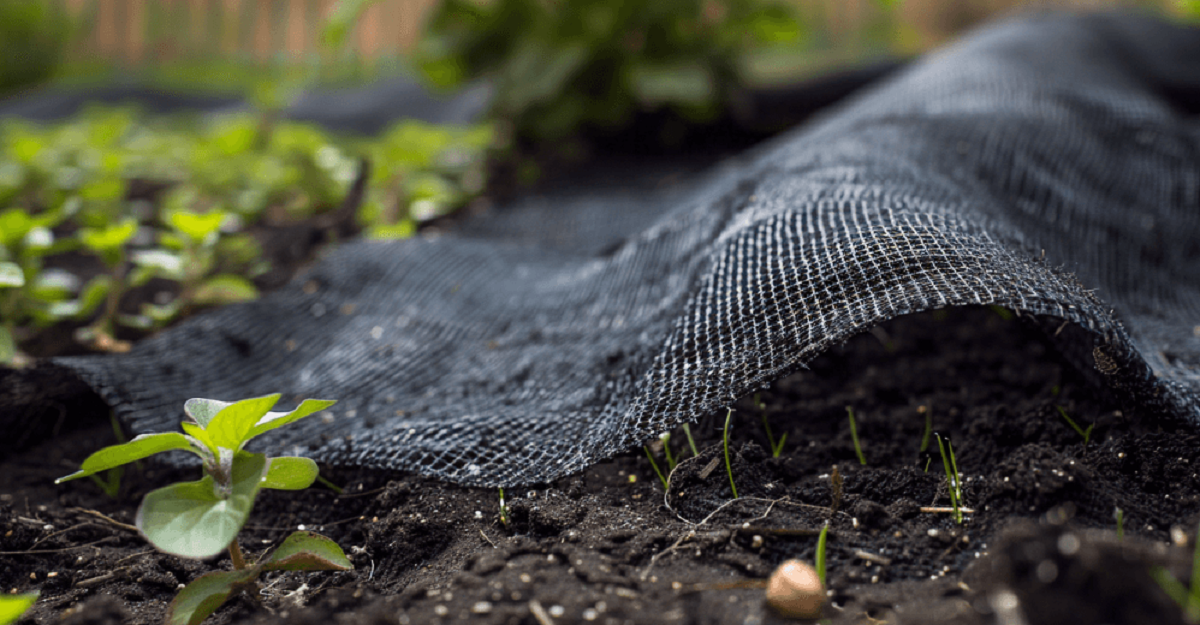
Publisher: diy-ideas.oss-accelerate.aliyuncs.com
Geotextile plays a vital role in landscaping projects. This material helps improve soil stability & manage water flow. It consists of synthetic fibers used for ground separation. Different types of geotextiles include woven & non-woven options. Each type has unique properties & applications.
Using geotextile can prevent soil erosion effectively. It retains soil while allowing water drainage. This makes it ideal for slopes & garden beds. Geotextiles are also beneficial for controlling weed growth. They create a barrier that allows water & nutrients to pass through.
| Type of Geotextile | Main Use |
|---|---|
| Woven | Soil stabilization |
| Non-woven | Separation & filtration |
And another thing, geotextiles enhance the aesthetics of landscaping. They help maintain clean lines & promote healthy plant growth. Installation is straightforward & can be done in various settings. From residential gardens to commercial projects, the benefits are clear.
- Improves drainage & airflow.
- Reduces maintenance needs.
- Supports ecological balance.
Integrating geotextiles into landscaping ensures durability. They serve as long-lasting solutions to common garden challenges. Properly selected & installed geotextiles lead to sustainable landscapes. Their effectiveness can be seen over time, making them a smart choice for any project.
Choosing the Right Geotextile for Your Project

Publisher: www.singhalglobal.com
Choosing the right geotextile is crucial for project success. Many factors influence this decision. Different types of geotextiles serve various purposes. Selecting the proper kind aids in soil stabilization & erosion control. Geotextiles are classified into three primary categories: woven, non-woven, & composite. Each category has unique features suitable for specific applications.
Woven geotextiles are strong & excellent for high-strength applications. They provide superior drainage & filtration. Non-woven geotextiles are versatile & perform well in filtration & separation. Their flexibility makes them suitable for a wide range of projects. Composite geotextiles combine the strengths of woven & non-woven types for enhanced performance.
| Geotextile Type | Key Features |
|---|---|
| Woven | High strength, excellent drainage |
| Non-woven | Flexible, good filtration |
| Composite | Combines strengths of both |
Consider your project’s specific needs. Evaluate factors like soil type, expected loads, & environmental conditions. Assessing these elements ensures the best match between geotextile & project requirements. Consulting with experts can provide valuable insights. Sampling different types can also lead to informed choices.
- Identify project goals & constraints.
- Research local regulations & standards.
- Consider project budget & cost-effectiveness.
Testing geotextiles in field conditions is essential. This helps verify performance before large-scale use. Ultimately, careful selection promotes project durability & efficiency.
Installing Geotextile: Best Practices

Publisher: titanenviro.com
Installing geotextile requires specific practices to ensure effectiveness. Proper preparation of the site is crucial. Begin by clearing vegetation & debris from the installation area. Smooth out the ground to create an even surface. This helps prevent wrinkles & improves drainage.
| Preparation Step | Importance |
|---|---|
| Clear Vegetation | Reduces material interference |
| Smooth Ground | Improves installation quality |
Next, install the geotextile in a moment that allows for optimal tension. Overlapping seams provide additional strength. Ensure the overlap is at least 12 inches for best results. Secure the edges with stakes or pinning materials to prevent shifting.
- Ensure proper tension during installation.
- Overlap seams at least 12 inches.
- Use stakes to secure the material.
After positioning, avoid heavy machinery traffic immediately after installation. A settling period is essential for the fabric to stabilize. Monitor for any signs of movement or shifting during this time.
| Follow-up Action | Effectiveness |
|---|---|
| Limit Machinery Use | Prevents damage to the fabric |
| Monitor Stability | Ensures proper functioning |
Regular maintenance is vital for longevity. Inspect the geotextile periodically for any damage. Address issues promptly to maintain drainage efficiency. This ensures long-term benefits for your project.
Maintenance & Longevity of Geotextile

Publisher: image.made-in-china.com
Proper maintenance of geotextiles is essential for maximizing their lifespan. Regular inspections ensure that any signs of wear or damage are detected early. Cleaning the surface removes debris, enhancing performance & longevity. Avoid leaving heavy machinery or vehicles parked directly on geotextiles for extended periods. This often leads to compaction or tears. Promptly repairing any damage prevents further degradation. It is vital to follow manufacturer guidelines for maintenance & repair methods.
| Key Maintenance Activities | Expected Benefits |
|---|---|
| Regular Inspections | Identifies potential issues early. |
| Surface Cleaning | Enhances performance & aesthetics. |
| Timely Repairs | Prevents further damage & extends lifespan. |
Geotextiles require proper installation to ensure longevity. Ensure correct soil preparation before placement. Select the right type of geotextile based on specific applications. Avoid exposing geotextiles to harsh chemicals, as they can cause deterioration. Maintain proper drainage to prevent water accumulation, which can weaken materials over time.
- Ensure correct placement during installation.
- Avoid chemical exposure to preserve integrity.
- Regularly assess drainage systems for efficiency.
Further understanding geotextile maintenance leads to better performance. Long-lasting materials save costs in the long run. Regular attention to detail ensures continued effectiveness in applications. A proactive approach guarantees value from your geotextile investments.
Geotextile Quality Control & Standards

Publisher: www.instron.com
Quality control is crucial for geotextile performance. Standards ensure the reliability of materials. They influence project success significantly. Geotextile materials must meet specific criteria. This includes physical, chemical, & mechanical properties. Compliance with guidelines is essential for safety & performance. Industry standards are created by recognized organizations. ASTM & ISO are key standard-setting bodies. Regular testing helps maintain high-quality production.
| Testing Type | Description |
|---|---|
| Tensile Strength | Measures the force required to break the material. |
| Puncture Resistance | Assesses the ability to resist penetration from sharp objects. |
Quality assessment involves various procedures. Initial sampling begins at production. Samples undergo rigorous lab testing. Results determine if the batch meets specifications. Non-conformance triggers corrective actions to prevent defective products.
- Visual inspection for defects
- Weight & thickness measurements
- Durability assessments in various environments
Traceability is essential in quality control. Each batch must have documentation tracking origin & tests. This transparency builds trust with consumers. Compliance with regulations enhances project feasibility. Continuous improvement in processes ensures quality maintenance. Regular audits help in adapting to new standards. Adhering to these practices supports industry growth.
Future Innovations in Geotextile Technology
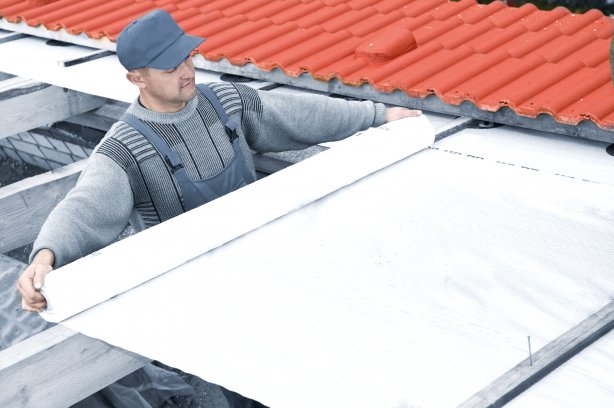
Publisher: www.innovationintextiles.com
Future innovations in geotextile technology promise significant advancements. Sustainable materials will become more integral in manufacturing. Increased focus on biodegradable geotextiles is on the rise. These materials reduce environmental impact & enhance soil health. Researchers explore nanotechnology to improve geotextile performance. Enhanced filtration & drainage properties are key benefits. Smart geotextiles with embedded sensors will monitor structural integrity. Real-time data collection will inform maintenance & usage. Developments in geosynthetic clay liners improve landfill management. This enhances waste containment & protects groundwater. Improved manufacturing techniques will lower production costs. This encourages wider use in diverse applications. Collaboration across industries will drive these innovations forward. Partnerships with universities & research institutions will be vital. Future geotextiles will feature advanced durability & strength. This will extend their lifespan in various applications. Enhanced resistance against environmental stressors will be critical. Emerging markets will see increased adoption of geotextiles. Urban infrastructure projects will benefit greatly from innovations. The construction sector will utilize advanced geosynthetics for better outcomes. Environmental protection & sustainability will remain top priorities. Future advancements will focus on efficiency & cost-effectiveness. As technology evolves, geotextiles will adapt to meet new challenges. Stronger regulations will drive demand for innovative geotextile solutions. The integration of geotextiles in climate resilience projects is essential.
| Innovation | Description |
|---|---|
| Biodegradable Geotextiles | Reduction of environmental impact. |
| Smart Geotextiles | Real-time data collection for maintenance. |
| Nanotechnology | Improved filtration & drainage properties. |
- Increased durability against environmental stressors.
- Lower production costs through new manufacturing techniques.
- Integration in urban infrastructure projects.
The Sustainability of Geotextile
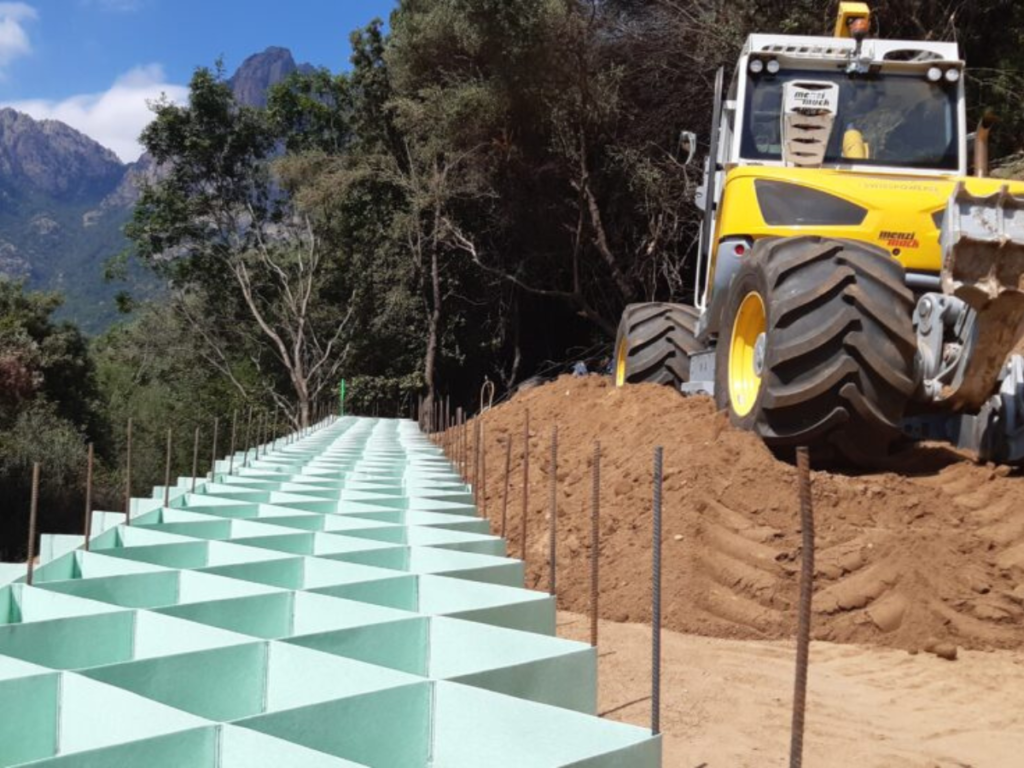
Publisher: railway-news.com
Geotextiles are eco-friendly materials, offering sustainable solutions for various applications. Their production often utilizes recycled materials, reducing waste. These fabrics help in soil erosion control & promote vegetation growth. By improving soil stability, geotextiles minimize the need for chemical interventions.
One of their key benefits is reducing water runoff. They facilitate water absorption & filtration in soil. This capability aids in water conservation, leading to sustainable land management practices. Geotextiles also contribute to sustainable road construction, reducing the environmental impact of infrastructure projects.
| Benefits of Geotextiles | Environmental Impact |
|---|---|
| Soil erosion control | Reduces habitat destruction |
| Water conservation | Enhances groundwater recharge |
| Reduced use of chemicals | Minimizes pollution |
Recycling & reusing geotextiles further enhance their sustainability. They can be repurposed for different applications after their initial use. This circular approach supports waste reduction & resource conservation.
- Improves agricultural practices
- Supports sustainable construction
- Promotes biodiversity
Innovations in material technology also lead to biodegradable geotextiles. Such materials break down over time, leaving no long-term impact. Consequently, they contribute to a cleaner environment & less landfill waste.
Overall, the sustainability of geotextiles reflects their versatility & eco-friendliness. Their integration into various sectors fosters a more sustainable future. Investing in geotextiles positively influences environmental & economic health.
Geotextile & Global Infrastructure Development

Publisher: www.maximizemarketresearch.com
Geotextiles play a vital role in global infrastructure development. These materials enhance soil stability & drainage systems. Their applications span across various construction projects worldwide. Roads, bridges, & dams greatly benefit from geotextile usage.
Geotextiles support environmental sustainability as well. They help manage erosion & sediment control effectively. Their innovative designs contribute to greener construction practices. The integration of geotextiles reduces material costs & project timeframes.
| Application | Benefits |
|---|---|
| Road Construction | Improved Load Distribution |
| Drainage Systems | Enhanced Water Flow |
| Erosion Control | Soil Stabilization |
Many countries have adopted geotextiles in their infrastructure projects. This adoption proves their effectiveness & reliability. As urban populations increase, infrastructure demands rise. Geotextiles offer solutions that align with modern requirements.
- Cost-effective construction methods
- Innovative solutions for soil management
- Increased durability of infrastructure
And don’t forget, geotextiles support climate adaption initiatives. Their properties assist in managing water flow & reducing flood risks. This is critical for many regions facing climate challenges. As global infrastructure progresses, geotextiles will remain essential.
Case Studies: Successful Geotextile Applications
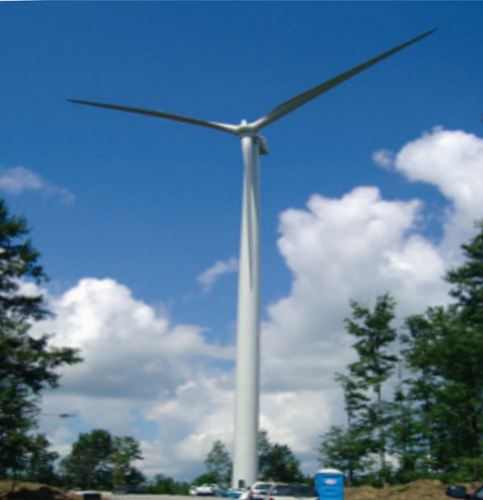
Publisher: www.tensarcorp.com
Case studies highlight innovative uses of geotextiles across various industries. These applications showcase the effectiveness & versatility of geotextiles in real-world scenarios. Multiple projects demonstrate how geotextiles can improve performance, sustainability, & longevity.
| Project Name | Application |
|---|---|
| Green Roof Project | Drainage & filtration for vegetation support |
| Highway Construction | Soil stabilization & erosion control |
| Landslide Prevention | Reinforcement of slopes using geotextile |
Geotextiles have emerged as critical components in numerous construction & environmental projects. They play a significant role in improving soil stability. These applications are evident in transportation, civil engineering, & landscape architecture.
- Geotextiles enhance the performance of retaining walls.
- They provide crucial filtration in drainage systems.
- These materials are effective in reducing hydraulic pressure.
Another notable example is the use of geotextiles in erosion control on shorelines. Here, they protect the land from wave impact & sediment loss. The success of these applications demonstrates the reliability of geotextiles in challenging environments.
| Benefit | Description |
|---|---|
| Cost-Effectiveness | Reduces construction costs by minimizing soil failure risks |
| Longevity | Offers extended durability in harsh conditions |
| Environmental Protection | Minimizes pollution & enhances natural habitats |
Overall, these case studies exemplify how geotextiles contribute to successful project outcomes. With their variety of applications, they remain essential in modern engineering practices. Their diverse benefits solidify their importance across multiple sectors.
The Importance of Proper Disposal of Geotextile
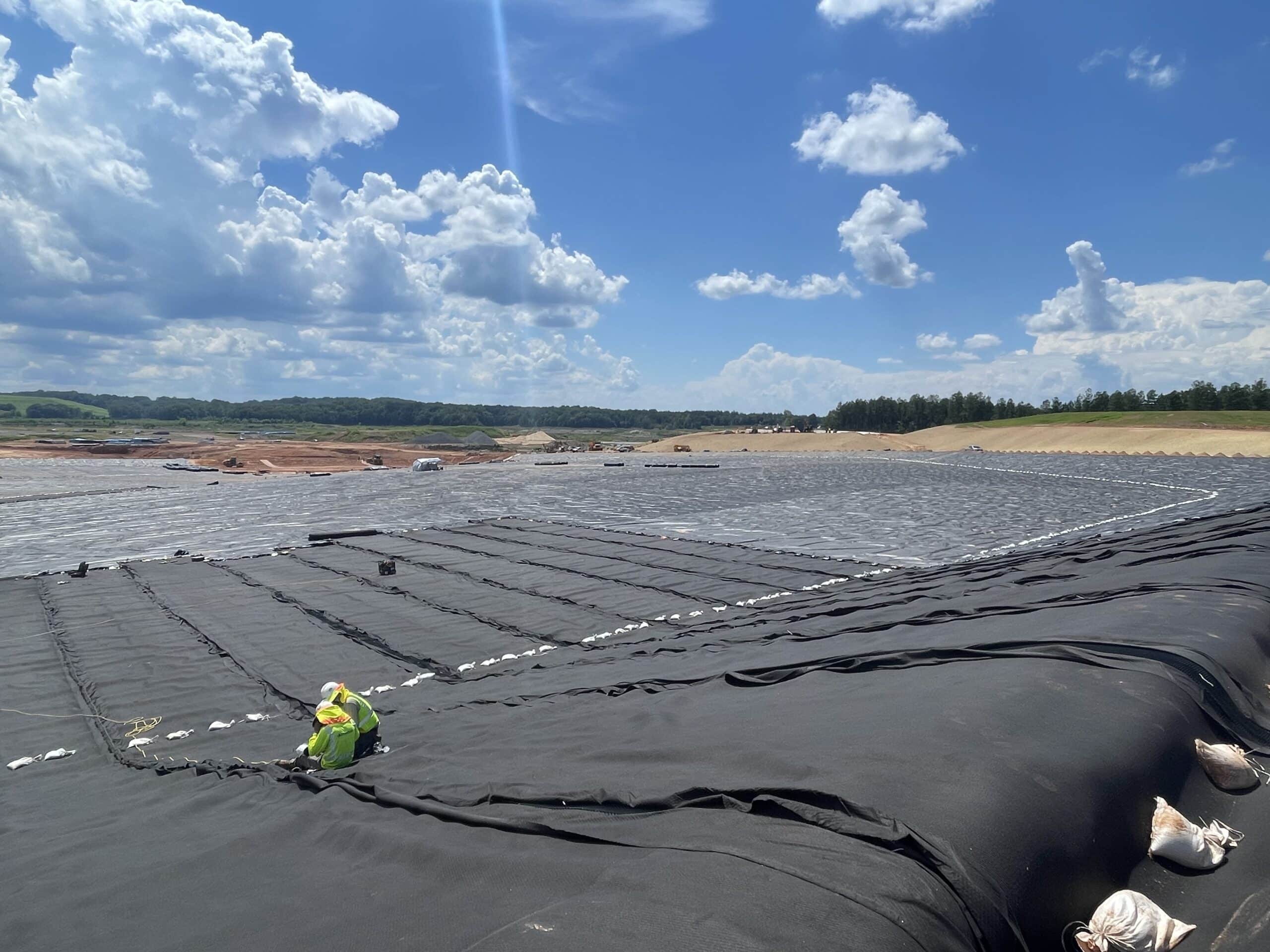
Publisher: www.smeinc.com
Geotextiles play a crucial role in construction & civil engineering. These materials require proper disposal to prevent environmental harm. Improper disposal can lead to soil contamination & water pollution. Waste management systems must incorporate geotextiles in their processes.
Landfills are often the final destination for discarded geotextiles. Be that as it may, this is not ideal due to their synthetic nature. Geotextiles can take many years to decompose. Alternative disposal methods should be explored to minimize their environmental impact.
| Disposal Method | Impact on Environment |
|---|---|
| Landfill | High contamination risk, long degradation time |
| Recycling | Reduces waste, saves resources |
| Waste-to-energy | Generates energy, minimizes waste |
Awareness around geotextile disposal is crucial for construction firms. Training workers on sustainable practices can make a significant difference. Environmentally conscious practices improve company reputation & compliance with regulations.
- Promotes sustainability in construction projects.
- Reduces landfill waste & pollution.
- Encourages recycling initiatives.
- Supports eco-friendly community efforts.
Proper disposal methods can extend the lifespan of geotextiles. Advanced techniques such as recycling & waste-to-energy should be implemented. Overall, the importance of managing geotextile disposal cannot be overstated.
Conclusion: Geotextile as a Sustainable Solution
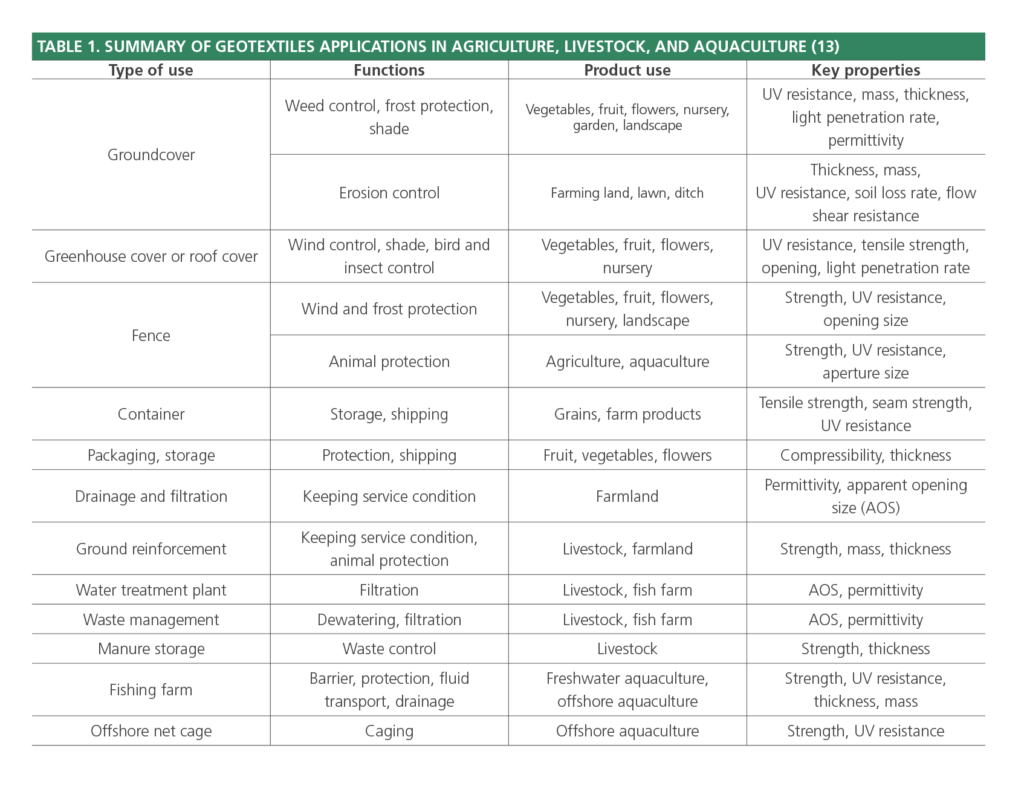
Publisher: geosyntheticsmagazine.com
Geotextiles are an important resource for sustainable development. They promote eco-friendly construction methods while reducing environmental impact. By minimizing soil erosion, they support land preservation. Geotextiles enhance drainage, ensuring better water management in various applications. Their longevity makes them a cost-effective choice over time. Resource efficiency is improved through reduced waste in construction processes. Natural materials often replace synthetic ones, aligning with sustainability goals.
Incorporating geotextiles leads to improved soil stability. They provide structural reinforcement for various infrastructures. A range of applications demonstrates their versatility in civil engineering. Roads, embankments, & retaining walls benefit considerably from their use. They aid in preventing soil displacement & contamination, preserving natural ecosystems.
| Benefits of Geotextiles | Impact on Sustainability |
|---|---|
| Soil erosion control | Protects landscapes & ecosystems |
| Improved drainage systems | Reduces waterlogging & flooding risks |
| Cost efficiency | Lower maintenance & replacement costs |
Choosing geotextiles reflects a commitment to sustainable practices. They support climate resilience by adapting to environmental changes. Their role in waste reduction emphasizes the importance of innovative materials. As communities seek greener solutions, geotextiles stand out as an effective choice.
- Enhanced durability in diverse environments
- Support for local ecosystems
- Increased project efficiency & effectiveness
Overall, adopting geotextiles in construction signifies a shift towards sustainability. These materials help integrate ecological considerations into modern infrastructure projects.
Geotextiles are a practical solution for improving soil stability & protecting the environment. They help prevent erosion, manage water flow, & support vegetation growth. By using these materials, we can make our landscapes safer & more sustainable. Geotextiles are beneficial in various projects like roads, landscaping, & agriculture. They save time & money while promoting healthier ecosystems. As we continue to see challenges like climate change, these materials will play a vital role in shaping our future. Embracing geotextile applications benefits both our communities & the environment, making it a win-win for everyone involved.
Visit for related posts = civil construction and geotextile

